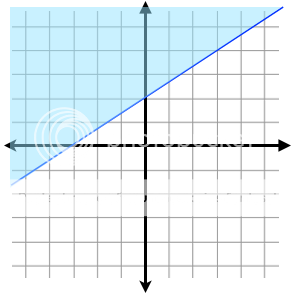Could someone please explain how to solve these two questions:


Thank you...

Thanks for the quick response...Anurag@Gurome wrote:Explanation to Q2:
2x - 3y ≤ -6 implies y ≥ (2x/3) + 2
Let us draw the above line in the coordinate system. Let us write the line in the form, x/A + y/B = 1.
So, the line is x/(-3) + y/2 = 1
It can be seen that the mentioned area is above quadrant IV and does not contain any point of this quadrant.
The correct answer is E.
Anurag@Gurome wrote:Explanation to Q2:
2x - 3y ≤ -6 implies y ≥ (2x/3) + 2
Let us draw the above line in the coordinate system. Let us write the line in the form, x/A + y/B = 1.
So, the line is x/(-3) + y/2 = 1
It can be seen that the mentioned area is above quadrant IV and does not contain any point of this quadrant.
The correct answer is E.
Hi btthus!btthus wrote:Thank you for the quick response...
Would the ≥ v.s. =, change the answer? What is the reasoning for using ≥ instead of =?


Whitney Garner wrote:Hi btthus!btthus wrote:Thank you for the quick response...
Would the ≥ v.s. =, change the answer? What is the reasoning for using ≥ instead of =?
The presence of the ≥ is essential and so let's make sure that we clearly explain it! The question is asking for the empty quadrant if we graph the inequality 2x - 3y ≤ -6. See, this isn't just a line, this is actually the expression for an AREA or REGION of the graph. That is the difference between the ≤ and the = sign: an = would be just the line, the inclusion of the < or > will determine which side of the line we would shade (and I'll explain how simply knowing that the line doesn't pass through quadrant 4 is NOT enough to say that quad 4 would be empty!!) So let's practice graphing inequalities!
Step 1: Get the Inequality in Slope-Intercept Form (y=mx+b)
You can certainly graph lines in several ways, but the easiest way to graph an inequality is to put it in y=mx+b form.
y = mx + b (where M is the slope and B is the Y-intercept = solve the inequality for Y).
2x - 3y ≤ -6
-3y ≤ -2x - 6
y ≥ (2/3)x + 2 ...(flip the sign due to division by negative)
Step 2: Graph this as a LINE (equality)
Noe we want to ignore the ≥ symbol and just make it an = sign.
y = (2/3)x + 2
This means we have the y-intercept at +2, and the slope is +(2/3). Since we don't really care about specific points on this graph, we just need to have a line that hits the Y-axis above the origin and is upward sloping (I graphed this with the accurate intercepts but you DO NOT need to here - just get a general location on the grid):
Step 3: Shade in the Inequality Region
Once we are in y=mx+b form this is actually VERY easy. Because our actual inequality is y ≥ (2/3)x + 2, we shade the area on the side of the line where Y is larger than the line (so shade the area where Y-axis values are higher - that means ABOVE the line. And that is IT - you're done!!
Now we can see that the empty quadrant is Quadrant IV. But what would have happened if when we solved for the inequality we ended up with y ≤ (2/3)x + 2? If you guessed that we would have shaded the area BELOW the line, you would be exactly right!! And that would mean that there were NO empty quadrants! So we can see how important the presence of the ≤ or ≥ actually is!!
Hope this helps!
Whit